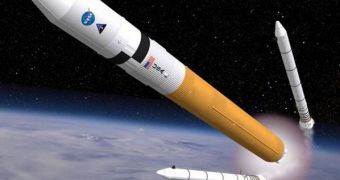Since Congress mandated NASA to start work on a new generation of heavy-lift delivery systems, the space agency has been hard-pressed to come up with plans on how to build the monster rocket. Now, engineers decided to use solid rocket boosters to power up the rocket, at least for now.
The first few flights of the Space Launch System (SLS) will rely on solid fuel boosters, mounted on each side of the rocket, like in space shuttles' launch configuration. Later on, NASA plans to replace them with a yet-undeveloped engine powered by liquid kerosene.
Industry and congressional sources say that NASA Administrator Charles Bolden has already approved the new design, which is now waiting for a final seal of approval from the White House Office of Management and Budget.
Bolden says that the core stage of the SLS will be using propulsion systems derived from the space shuttles, while the upper stages will rely on Apollo-era engines and thrusters. The whole point of the SLS is to be constructed with existing technologies.
Congress wants to gain the ability to put hundreds of tons of cargo in space, but it wants NASA to do so at a minimal cost, and using as much as possible from the technologies developed for the Apollo Moon rockets, the space shuttles and Project Constellation.
Under the latter, NASA was supposed to build the ARES V heavy-lift delivery system, which would have been enormous, and allowed for continuous space exploration beyond low-Earth orbit (LEO).
But the design, along with those for the ARES I and IV boosters, the Altair lunar lander, the Earth-Departure Stage and the fully-fledged Orion Crew Exploration Vehicle, was cast aside by the Obama Administration in 2010, following the conclusions of a review.
Magna, Utah-based ATK Aerospace Systems will construct the first side-mounted boosters for the SLS. The company is already under contract with NASA to develop a more advanced version of the space shuttle engines.
During its first flights, the SLS will rely on these engines to help it reach orbit. In the long-run, when the liquid kerosene-powered engines will be introduced, the motors will most likely be manufactured by other companies.
Already involved in this race are Sacramento-based Aerojet, Space Exploration Technologies (SpaceX), from Hawthorne, and Pratt & Whitney Rocketdyne, which is headquartered in Canoga Park. Interestingly, all of these companies are from California, Space reports.

 14 DAY TRIAL //
14 DAY TRIAL //